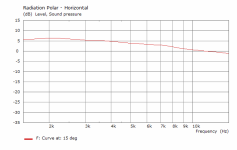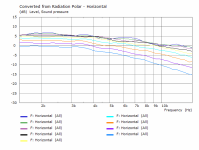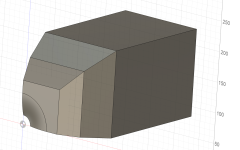You can cross them at 2kHz without problem, active even at 1,8kHz for "normal" listening levels. I built a few speakers with them now and measured power compression and coil temperature/failure compared to a scan speak Beryllium 1".The T25a was certainly well thought out for what it’s meant for…..a very high crossover point with a small chassis for close C to C placement…….meaning it would work very well with a dome mid……perfect actually.
The only real limiting factor might be power handling I suppose…….
The ScanSpeak can take a little more power (about 15W when I remember right) and cools with it's membrane (get's up to 80°C!) but has less sensitivity. Bliesma takes about 10W (that's a pure sine wave, not music!), membrane stays cooler (worse heat transfer) but with it's higher sensitivity they reach the same SPL level. Both have about 2dB power compression at this point, when you get up to 3dB they get destroyed.
These Bliesma drivers are at least as robust as other High End drivers, I really tested them. Don't know where the idea comes from they are not?
Hypex has a 4way DSP in the pipeline, it should appear soon. This would streamline your setup a lot and I would not go analog through 2 digital crossovers for the top. The digital input is great btw, you just need a device in front for controlling level (I use WiiM preamp or RME).I will use a MiniDSP Flex to handle the filtering for the subs. This is a 2-in / 4-out DSP processor. The Hypex amps will of course handle the filtering for the main 3-way.
I have also chosen to use the Scan Speak 26W-4867T00 as the woofer, and the Bliesma T25A as the tweeter.
Why don't you use 2 26W-4867 as 3.5 way? Or SB34NRXL75-8 or even 2 of them?
Of course a dedicated woofer system which is optimal positioned in the room has a lot of benefits! But for the concept of the speaker it is not needed?
(Sorry if this was already discussed, not so regular active here at the moment)
As there is good discussion on the sound of the tweeters and especially metal domes. I will add my recent experience with 27TAC/GB. I have it in 2way closed box with PTT6.5X04 (efect loudspeaker for custom home cinema). It has the clarity, good level of the details, and not dull in any way. I will use this tweeter again very likely.
You can cross them at 2kHz without problem, active even at 1,8kHz for "normal" listening levels. I built a few speakers with them now and measured power compression and coil temperature/failure compared to a scan speak Beryllium 1".
The ScanSpeak can take a little more power (about 15W when I remember right) and cools with it's membrane (get's up to 80°C!) but has less sensitivity. Bliesma takes about 10W (that's a pure sine wave, not music!), membrane stays cooler (worse heat transfer) but with it's higher sensitivity they reach the same SPL level. Both have about 2dB power compression at this point, when you get up to 3dB they get destroyed.
These Bliesma drivers are at least as robust as other High End drivers, I really tested them. Don't know where the idea comes from they are not?
The HD comes on hot and heavy at 3k……I suppose it would depend on the designers performance goals from the start. If we’re talking a classic two way with a 6” midwoofer?…..sure…..compromises have already been made so why not. Choosing a 3way with a dome mid?…….can’t see a reason to compromise anymore……the table is set and the menu chosen.
The woofer concept was discussed in posts 35 - 171, and there was a lot of discussion with ideas from many people. I originally was planning on 2 x 10" woofers, most likely in a 3.5 way configuration. I gave serious consideration to four different woofers: Dayton RSS265HF-8, SS Revelator 26W/8867T, SS Discovery 26W/8534G, and Faital Pro 10RS430.Why don't you use 2 26W-4867 as 3.5 way? Or SB34NRXL75-8 or even 2 of them?
The rationale for my decision to go with a 4-way configuration using my existing (sub)woofer cabinets is in Post 171 . An additional reason I did not mention is that in my room, the ideal positions for the main speakers is not the ideal positions for the woofers/subwoofers.
My personal guidelines for harmonic distortion performance are based on a review of audibility studies, the best practices and advice of experienced designers, and my own judgement. I don't expect everyone to agree with me.The HD comes on hot and heavy at 3k……I suppose it would depend on the designers performance goals from the start.
At 95 dB SPL, I want 2nd HD to be at 1% (-40 dB) or less from 100 Hz up.
At 95 dB SPL, I want 3rd HD to be at 0.5% (-46 dB) or less from 75 Hz up.
I want HD4 and HD5 to be equal to or less than HD3.
Based on my guidelines, I would be comfortable using the Bl T25A from 2k up.
j.
"Hot and heavy at 3k" ?!?!?
T25x has one of the cleanest drives available, according to Hificompass measurements @11V/105dB there is < 1% k2 and < 0,1% k3 from 2kHz on.
@hifijim : Maybe you missed it in #319:
Best regards
Peter
T25x has one of the cleanest drives available, according to Hificompass measurements @11V/105dB there is < 1% k2 and < 0,1% k3 from 2kHz on.
@hifijim : Maybe you missed it in #319:
Would you be so kind and share a screenshot? Thanks a lot!I would be curious on the power response just in the horizontal domain / from the horizontal FR simulations. Do you mind to show a screenshot? Thanks a lot!
Best regards
Peter
Last edited:
yes.......from 3k to 2k, H3 rises more than 20db and another 20db from 2k down to 1k......that's trending in my book and that qualifies for the adjectives i used.
The application is not to cross it to a dome mid at 2k but 3k instead. Personally i would't cross any dome tweeter at 2k or below....i'd choose the offset in directivity as my compromise any day of the week. But hey, that's just me....i physically treat my listening spaces so i don't have to struggle with power response in the design phase.
And let's be honest......why use a dome mid if it can't play to 3k or beyond.....that doesn't make any sense to me.
And let's be honest......why use a dome mid if it can't play to 3k or beyond.....that doesn't make any sense to me.
Horizontal and VerticalMaybe you missed it in #319:
Would you be so kind and share a screenshot? Thanks a lot!
Now Horizontal only
I don't think it is so simple...from 3k to 2k, H3 rises more than 20db and another 20db from 2k down to 1k......that's trending in my book and that qualifies for the adjectives i used.
From 3k to 2k, H3 rises from -85 dB to -65 dB, which means it rises from unmeasurable up to insignificant. Then from 2k to 1k it rises from -65 dB to -50 dB, which means it rises from insignificant to measurable-but-still-excellent. Considering that at 1k we are below the driver Fs, it is still pretty impressive.
j.
Here are some simulation outputs of a very simple waveguide for the T25A that is 6mm deep. It is more consistent and even than a bare driver and given the size constraints, it fit's on the same diameter as the driver or can be made to. These are non normalized and show 1500 to 15K 0 to 90 degrees in 10 degree steps. The response is pretty much within 1 or 2 dB 0 to 40 degrees and is an even 10 dB down across the board at 90 degrees vs 0.The tweeter may have a waveguide, depending on what sort of magic that @fluid can conjure up...
There is diffraction on axis because this is a BEM model with fully reflective boundaries. All sharp edges and creases on the baffle of which there are a few that are also symmetric show the worst case scenario. A real wooden baffle with smoothed edges and a less symmetric profile would offset this to some extent.
If you want to make one to try, I will make a printable model for you if that is what you want.
Attachments
The OD of the profile is 104mm in the simulation, but that is quite arbitrary. It can be changed if there is a reason to.What is the approximate outer diameter of the waveguide? It looks like about 100 mm , yes?
The flat area around it was 146mm square with the waveguide centred in it.
Well, sometimes vertical and horizontal power response are significantly different but both in sum is flat. I just wondered if horizontal power response somehow differs from overall power. But it looks good, also very linear. 😀you have made me curious... what insight can be drawn from a sound power curve which is calculated from only the horizontal polar responses ?
P.S.: some example where the vertical drop in power caused by xover, compensates excess in power in the horizontal domain caused by baffle diffraction (from me, sorry no full spin; 7-8 years ago, first time I used Vituixcad.):
Last edited:
@fluid -
From my standpoint, there is no advantage to a smaller waveguide chassis. Perhaps we should use the entire 120mm diameter so there is a generous flat region for screw holes?
I do not own a 3D printer, so I will send the digital model out to a fabricator for printing.
Thank you again !
j.
Yes, I am interested. How do you envision attaching the tweeter to the waveguide? Reading through some threads, it seems there are several approaches.If you want to make one to try, I will make a printable model for you if that is what you want.
From my standpoint, there is no advantage to a smaller waveguide chassis. Perhaps we should use the entire 120mm diameter so there is a generous flat region for screw holes?
I do not own a 3D printer, so I will send the digital model out to a fabricator for printing.
Thank you again !
j.
You forget an important fact - level of the tweeter is 6dB down at the crossover point. You get significant less THD at the crossover point.View attachment 1408602
The HD comes on hot and heavy at 3k……I suppose it would depend on the designers performance goals from the start. If we’re talking a classic two way with a 6” midwoofer?…..sure…..compromises have already been made so why not. Choosing a 3way with a dome mid?…….can’t see a reason to compromise anymore……the table is set and the menu chosen.
But you don't have to believe my words - cause I have the measurements 🤓
When you cross over a tweeter to low you get a THD hump around the cross over frequency, easy to spot. I just had a look, my prototype was crossed over acoustically at exactly 2kHz. Here is the THD curve over frequency and level:
Protection of the Hypex module sets in at the 108dBSpl curve. But as you see THD is smooth and EXTREMELY low in the 2-3kHz range. Bliesma T25x NEVER reaches 1% up to about 8kHz - it get's actually destroyed before it distorts!
And 2 12" don't bring the 3" to sweat, they run into strong compression before the 3" shows even a hint of it.
Don't chose your cross over frequency out of a "feeling" - do the measurements and power tests and then you KNOW that a 2kHz cross over for these tweeters is no problem at all.
I didn't save that measurement (only between mid and tweeter and the 12" nearfield) but somewhere over 400Hz, 420-440Hz. There is SOME rise of THD in the crossover area from the midrange but at 110dB it's still in the ballpark of the 2 12" and <1% ... that was good enough for me ;-)Where do you cross between the 12s and the 3" Bliesma?
At a more sane level THD is <0,1% over most of the audio band.
- Home
- Loudspeakers
- Multi-Way
- High Performance 3-way based on Bliesma M74A



